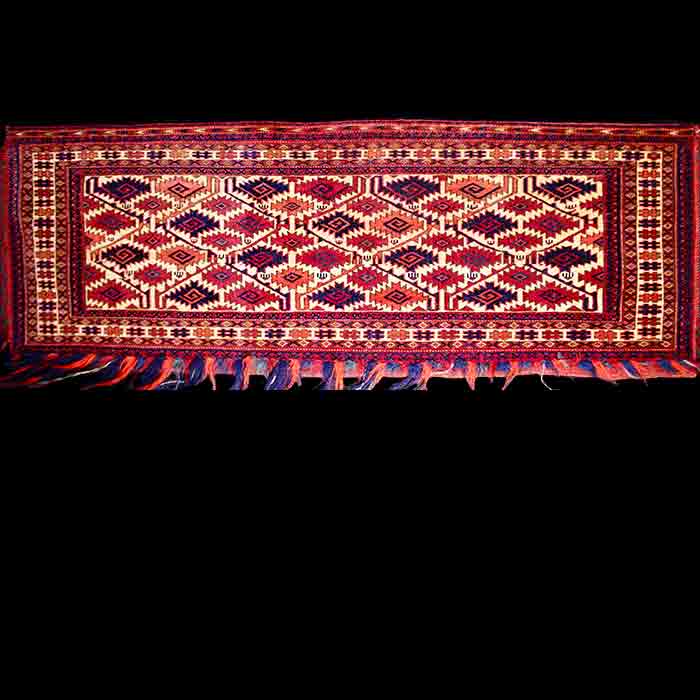Clay Stewart Collection of Türkmen Textiles
16. Ahal Teke Türkmen Ashyk To:rba
Ca. 1870 Size: 4 ft.1 1/2 in. x 1 ft. 5 in.
Ca. 1870 Size: 4 ft.1 1/2 in. x 1 ft. 5 in.

12 x 24 = 288 asymmetrical Persian knots per square inch, pulled slightly open to the left, symmetrical (very slightly depressed right warp) from the back with a knot width/height ratio of 1:2. Invisible weft from the back of double blond shoots. All wool foundation. Two inch remnants of long multi-colored strings pulled through along the bottom edge. Slightly depressed warps, on the right, when viewed from the back.
“Curled leaf pattern”, refers to a plant totem, archaic grape clusters, or possibly to early vita culture, all used for the promotion of blessings for good crops. Some curled leafs eminate from a stem and some are stemless diamond forms. The Ashyk major gul displays a lattice of six complete clusters of four Ashyk emblems each outlined in a randomly serrated diamond, against an ivory field. Ashyk is also referred to as dogajik. The main guard border has repeated pound sign motifs called it tapan, against an ivory back ground. Flanked on each side by a ok gezi (ozi) minor border which in turn are flanked by two yashil gochak minor borders. Older versions of this motif have randomly occurring small pyramids protruding out from the large grape vines, some protrude outward, some inward, that enclose the four Ashyk motifs, more recent examples do not. Goat knuckles are also associated with the Ashyk motif referring to it's shape and a traditional Turkmen game they played with the goat knuckles called astragali. Random, one quarter rotation of 45 degrees, E-forms, appear in the field as amulets, some maintain this is the inverted co-joined Armenian letter HE which is the first letter or the Armenian word for God Almighty. Single sichan ixi stripe across the width of the top lip. When this to:rba was hung with six others around the inside of the tuynuk, (flu) with the to:rba top pointing upwards to the stars, to collect the star’s energy and this conductivity is created and the energy is channeled into each metaphysical bag collecting its share of star energy by this sichan ixi stripe.
Decorative trapping linked to the well being of the tribe. Ultimately a religious device, but utilitarian in the sense that it had a function to collect star energy to ensure good crops for the coming year, therefore a plant totem.
Ahal Teke Turkmen quartering area in Ahal Oasis, SW Turkestan.
Visit Glossary page for any further definitions not highighted in red in a pop-up window.